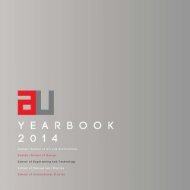EOY2013
You also want an ePaper? Increase the reach of your titles
YUMPU automatically turns print PDFs into web optimized ePapers that Google loves.
SSD 61<br />
design programmes<br />
B Des. (Bachelor of Arts In Design) – Interior Design - 4 years<br />
B Des. (Bachelor of Arts In Design) – Visual Communication - 4 years<br />
B Des. (Bachelor of Arts In Design) – Fashion and Textiles - 4 years<br />
Ph.D<br />
BASIC PHILOSOPHY<br />
The Bachelors in Design (B Des.) programme begins with a foundation year where the students are exposed to the<br />
multi-faceted world of the designer and the diverse skills that need to be developed for pursuing a career in design.<br />
The First Year (Foundation) programme is an introduction to concept development, technique, critical discussion and<br />
expression. Students develop a set of basic design skills and are introduced to methods of application. The programme<br />
trains students to evolve a distinct design approach and to develop a holistic attitude to the creative industries that they<br />
will choose to inhabit as professionals. Students apply their training in creative thinking and making to various mediums<br />
of expression and materials for construction, including textiles, ceramics, metal, wood, paper, canvas, board and natural<br />
materials. Students undergo a continuous learning process that culminates in the creation of a final design project at the<br />
end of four years. This project is expected to represent the acquired knowledge and skills of each student.<br />
SALIENT FEATURES OF TEACHING PEDAGOGY<br />
The Bachelors in Design (B Des.) programme allows the student to gain a foundation in design in the first year, and<br />
thereafter to branch out into three learning streams – Interior Design, Visual Communication, Fashion & Textiles. The<br />
delivery of content is achieved primarily in the studio format, supported by workshops, labs and lecture halls. The<br />
curriculum ensures that the student gets a consistent exposure and practice in the broad areas of learning, namely<br />
Design and Theory, Technology and Materials, Media and Technology, Discourse and Discovery, and Creative and Cultural<br />
production.<br />
SCHEME OF THE PROGRAMME<br />
Duration: 8 Semesters x 18 weeks per semester<br />
Teaching format: 30 contact hours per week<br />
Specialization: First Year common to all streams, followed by three years of specialized study. Stream of specialization to<br />
be selected after First Year.<br />
PROGRAmme STRUCTURE<br />
BACHELOR OF DESIGN<br />
The detailed programme structure of Foundation year and year two for Interior Design, as taught over the last year is<br />
outlined as follows:<br />
YEAR 1 - FOUNDATION<br />
Design Principles - The focus is given to design from a visual perception, with respect to various 2D and 3D form<br />
development capabilities according to their creative skills.<br />
Studio Materials - Material exploration and handling of the same innovatively is the key to great ideas. Developing the<br />
skill to do so is the purpose of this studio.<br />
Drawing - The objective of the course is to develop the basic fundamentals of drawing based on direct observation.<br />
The students are to develop hand and eye coordination, to make drawings more accurate. They are trained to ‘see’ rather<br />
than simply ‘look’, in order to develop their observation skills.<br />
History (Civilization & Technology) - The Course objective is to introduce students to global histories through objects.<br />
The objects chosen (from the project of the British Museum) all tell a story about how their local area has interacted with<br />
the wider world. It aims to encourage people to discover the power of objects.<br />
Research & Documentation - Research is all about addressing an issue, asking and answering a question or solving<br />
a problem, so the objective of this course is to introduce students to the ethical methods of exploration, conducting<br />
research, collecting information, analyzing it and documenting it appropriately in the fields of Art and Design.<br />
Portfolio Techniques - The development of visual problem-solving presentation assignments to enhance the students’<br />
personal portfolios. Portfolio techniques would make the students realize the importance of presentation skills and how<br />
different tools of design combine to create a portfolio.<br />
YEARBOOK 2013





